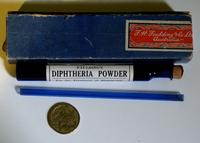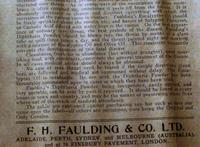
South Australian Medical Heritage Society Inc
Website for the Virtual Museum
Home
Coming meetings
Past meetings
About the Society
Main Galleries
Medicine
Surgery
Anaesthesia
X-rays
Hospitals,other organisations
Individuals of note
Small Galleries
Ethnic medicine
- Aboriginal
- Chinese
- Mediterran
Faulding's Diphtheria Powder
Acknowledgements: We are most grateful to Lyn Phillips for contacting us and sending us photographs of her mother Corry Phillips's Diphtheria Powder vial. Additional information was obtained from Lateline, (abc.net.au 22-9-2003) and Google.
In the middle of the 19th century the population of Victoria increased five fold to half a million (521,070) because of the "gold rush". The settlers mainly came from China, Europe, America and South East Asia in search of gold.
In 1872 an epidemic of diphtheria enveloped the world, and it is reported that in Australia each year 600 persons, mainly children perished from the disease.
Diphtheria was given its name by a French Physician, Pierre Bretonneau (1778-1862), using a Greek word
diphthera "prepared hide, leather", apparently referring to the leather-like membrane which
occurs in the oro-pharynx and can cause asphyxiation. He recommended tracheostomy with considerable success.
Early in the 20th century Emil von Behring published a paper indicating that immunisation using the diphtheria toxin was possible, and in the 1920's this was introduced world wide. It is now a part of a triple vaccine and no recent cases have been reported from the USA or other developed countries.
In the late 19th century, many Chinese gold miners were affected, and (before vaccine was
developed) the Chinese herbalists in Australia became noted for producing the Diphtheria Powder.
It became popular, and the South Australian Firm of Faulding produced the powder as suggested
by the Chinese herbalists Ah Sue and Fee Mun.
Dr. Blair of the Victorian Medical Society analysed the powder and stated that the powder contained:
"alum, carbonate of lime, nitrate of potash with camphor and mush". His report was not supportive,
and with the development of an effective vaccine the powder was no longer used.
There is little doubt that the Faulding's Diphtheria Powder was of some help in the treatment of
diphtheria.
It is unlikely that a reputable drug company would embark on its production without some beneficial
evidence.
The excerpt from the instructions may provide the reason. The firm recommends to clean and disinfect
everything that patients secretions came into contact with using their famous Eucalyptus oil
(Solyptol) and suggest additional use of "Phenytas" (a disinfectant made by Faulding)
or carbolic acid (phenol) as a spray and/or solution to kill the bacteria in the room.
This would very likely kill almost all viable organisms in the room and reduce the chance of
re-infection.
It is possible that the insufflation of the powder may have had some astringent benefit as well.


